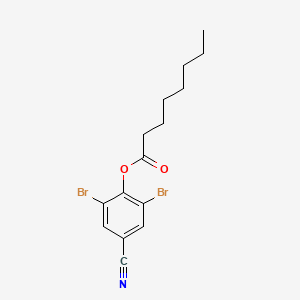D0819 | bromoxynil octanoate
| Toxicity | Dose | Time | Species | Model | Method | Action | Positive criterion | Reference |
|---|---|---|---|---|---|---|---|---|
| MEMBRANE POTENTIAL | 15.29±5.08 | human | qHTS-HepG2 | MMP assay | decrease | IC50 | 163 | |
| MEMBRANE POTENTIAL | 31.62 | human | HepG2 | MMP assay | decrease | IC50 | 163 | |
| MEMBRANE POTENTIAL | 28.63±22.68 | rat | hepatocytes | MMP assay | decrease | IC50 | 163 | |
| Pictogram | Signal | Statements | Precautionary Statement Codes |
|---|---|---|---|
    |
Danger |
H302: Harmful if swallowed [Warning Acute toxicity, oral] H317: May cause an allergic skin reaction [Warning Sensitization, Skin] H331: Toxic if inhaled [Danger Acute toxicity, inhalation] H361d ***: Suspected of damaging the unborn child [Warning Reproductive toxicity] H400: Very toxic to aquatic life [Warning Hazardous to the aquatic environment, acute hazard] H410: Very toxic to aquatic life with long lasting effects [Warning Hazardous to the aquatic environment, long-term hazard] |
P201, P202, P261, P264, P270, P271, P272, P273, P280, P281, P301+P312, P302+P352, P304+P340, P308+P313, P311, P321, P330, P333+P313, P363, P391, P403+P233, P405, and P501; (The corresponding statement to each P-code can be found at the GHS Classification page.) |
    |
Danger |
Aggregated GHS information provided by 96 companies from 6 notifications to the ECHA C&L Inventory. Each notification may be associated with multiple companies. H301 (14.58%): Toxic if swallowed [Danger Acute toxicity, oral] H302+H312 (39.58%): Harmful if swallowed or in contact with skin [Warning Acute toxicity, oral acute toxicity, dermal] H302 (85.42%): Harmful if swallowed [Warning Acute toxicity, oral] H312 (54.17%): Harmful in contact with skin [Warning Acute toxicity, dermal] H317 (100%): May cause an allergic skin reaction [Warning Sensitization, Skin] H319 (13.54%): Causes serious eye irritation [Warning Serious eye damage/eye irritation] H331 (100%): Toxic if inhaled [Danger Acute toxicity, inhalation] H361 (100%): Suspected of damaging fertility or the unborn child [Warning Reproductive toxicity] H400 (100%): Very toxic to aquatic life [Warning Hazardous to the aquatic environment, acute hazard] H410 (100%): Very toxic to aquatic life with long lasting effects [Warning Hazardous to the aquatic environment, long-term hazard] Information may vary between notifications depending on impurities, additives, and other factors. The percentage value in parenthesis indicates the notified classification ratio from companies that provide hazard codes. Only hazard codes with percentage values above 10% are shown. |
P201, P202, P261, P264, P270, P271, P272, P273, P280, P281, P301+P310, P301+P312, P302+P352, P304+P340, P305+P351+P338, P308+P313, P311, P312, P321, P322, P330, P333+P313, P337+P313, P363, P391, P403+P233, P405, and P501; (The corresponding statement to each P-code can be found at the GHS Classification page.) |
    |
Danger |
H302: Harmful if swallowed [Warning Acute toxicity, oral] H317: May cause an allergic skin reaction [Warning Sensitization, Skin] H331: Toxic if inhaled [Danger Acute toxicity, inhalation] H361d: Suspected of damaging the unborn child [Warning Reproductive toxicity] H410: Very toxic to aquatic life with long lasting effects [Warning Hazardous to the aquatic environment, long-term hazard] |
P201, P202, P261, P264, P270, P271, P272, P273, P280, P281, P301+P312, P302+P352, P304+P340, P308+P313, P311, P321, P330, P333+P313, P363, P391, P403+P233, P405, and P501; (The corresponding statement to each P-code can be found at the GHS Classification page.) |
| Organism | Test type | Route | Dose (normalized dose) | Effect | Source |
|---|---|---|---|---|---|
| rabbit | LD50 | skin | 1675mg/kg (1675mg/kg) | Pesticide Manual. Vol. 9, Pg. 100, 1991. | |
| rat | LD50 | oral | 250mg/kg (250mg/kg) | "Pesticide Index," Frear, E.H., ed., State College, PA, College Science Pub., 1969Vol. 5, Pg. 30, 1976. | |
| rabbit | LD50 | oral | 2gm/kg (2000mg/kg) | Guide to the Chemicals Used in Crop Protection. Vol. 6, Pg. 56, 1973. | |
| mouse | LD50 | oral | 245mg/kg (245mg/kg) | "Pesticide Index," Frear, E.H., ed., State College, PA, College Science Pub., 1969Vol. 5, Pg. 30, 1976. | |
| rat | LD50 | skin | > 2gm/kg (2000mg/kg) | Pesticide Manual. Vol. 9, Pg. 100, 1991. | |
| bird - wild | LD50 | oral | 175mg/kg (175mg/kg) | Pesticide Manual. Vol. 9, Pg. 100, 1991. | |
| mammal (species unspecified) | LD50 | unreported | 420mg/kg (420mg/kg) | "Chemistry of Pesticides," Melnikov, N.N., New York, Springer-Verlag New York, Inc., 1971Vol. -, Pg. 150, 1971. | |
| (2,6-dibromo-4-cyanophenyl) octanoate | 1689-99-2 | 2,6-DIBROMO-4-CYANOPHENYL OCTANOATE |
| 3,5-Dibromo-4-hydroxybenzonitrile octanoate | 3,5-Dibromo-4-octanoyloxy-benzonitrile | 4-Cyano-2,6-dibromophenyl octanoate |
| 689B992 | 86702-80-9; | 9HL5XAW9SK |
| A811047 | AX8018808 | BRN 2756636 |
| Benzonitrile, 3,5-dibromo-4-octanoyloxy- | Brominal W | Bromoxynil octanoate |
| Bromoxynil octanoate E.C. | Bromoxynil octanoate [ISO] | Bromoxynil octanoic acid ester |
| Bromoxynil-octanoate | Bromoxynil-octanoate, PESTANAL(R), analytical standard | C15H17Br2NO2 |
| CAS-1689-99-2 | CHEMBL1903970 | Caswell No. 119A |
| DQKWXTIYGWPGOO-UHFFFAOYSA-N | DSSTox_CID_3932 | DSSTox_GSID_23932 |
| DSSTox_RID_77234 | DTXSID7023932 | EINECS 216-885-3 |
| EPA Pesticide Chemical Code 035302 | FT-0727535 | HSDB 7308 |
| J-010497 | LS-38674 | NCGC00163996-01 |
| NCGC00163996-02 | NCGC00258621-01 | NPH 1320 |
| Octanoic acid ester of 3,5-dibromo-4-hydroxybenzonitrile | Octanoic acid, 2,6-dibromo-4-cyanophenyl ester | Octanoic acid, ester with 3,5-dibromo-4-hydroxybenzonitrile |
| Q22133404 | RP-16272 | S286 |
| SCHEMBL161072 | Tox21_201068 | UNII-9HL5XAW9SK |
| ZINC2039317 | [2,6-bis(bromanyl)-4-cyano-phenyl] octanoate | octanoic acid (2,6-dibromo-4-cyanophenyl) ester |
| CAS Number | 1689-99-2, 86702-80-9 |
| PubChem Compound | 15533 |

